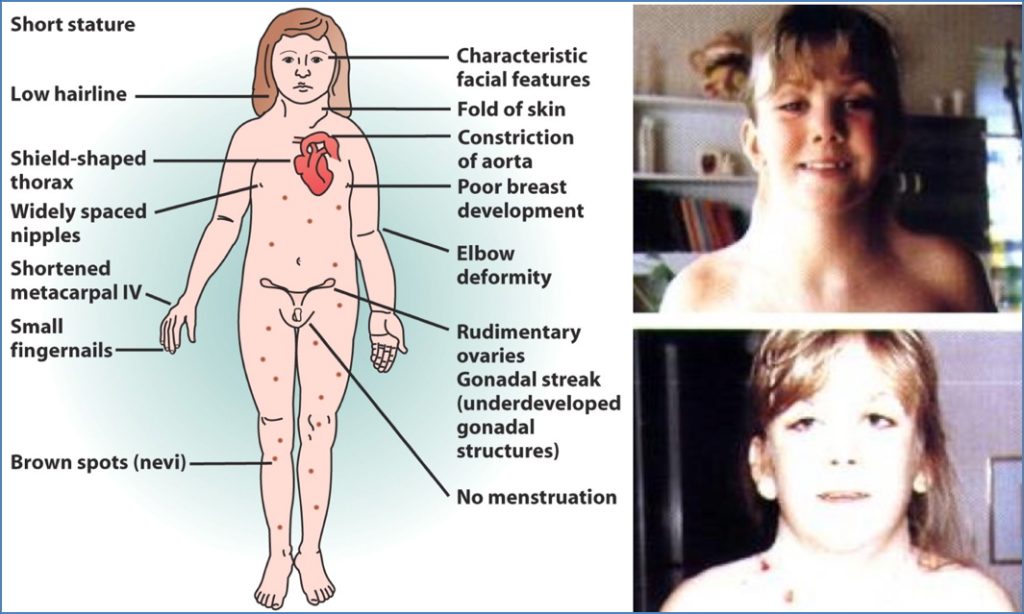Table of Contents
Overview – Turner’s Syndrome
Turner’s syndrome is a chromosomal disorder that affects biological females who are missing all or part of one X chromosome. Also known as 45,X or monosomy X, it is one of the most common sex chromosome abnormalities, though most cases result in miscarriage. Survivors often exhibit a distinct pattern of physical features, developmental issues, and infertility, with diagnosis often occurring at various stages of life depending on presentation.
Definition
Turner’s syndrome (45,X) is a chromosomal condition affecting females, caused by complete or partial absence of one X chromosome. It may present as a full monosomy, mosaicism, or structural abnormalities of the X chromosome.
Aetiology
- Chromosomal cause:
- Total or partial loss of one X chromosome
- Can be:
- Monosomy X (45,X): Classic and most severe form
- Mosaicism: Some cells have 45,X, others have 46,XX or structural variants
- Origin:
- Random error in paternal gametogenesis or early embryonic cell division
- Not typically inherited
Clinical Features
Prenatal and Neonatal:
- Many affected pregnancies result in miscarriage
- Cystic hygroma, hydrops fetalis, or congenital heart defects may be seen on antenatal scan
Postnatal and Childhood:
- Short stature (often presenting in late childhood)
- Webbed neck
- Low posterior hairline
- Broad chest with widely spaced nipples
- Lymphoedema of hands and feet (especially at birth)
- Delayed puberty or absent secondary sexual characteristics
- Infertility (due to ovarian dysgenesis)
Cardiovascular and Endocrine:
- Coarctation of the aorta
- Bicuspid aortic valve
- Hypertension
- Increased risk of type 2 diabetes and autoimmune thyroid disease (e.g. Hashimoto’s)
Other:
- Mild learning difficulties (particularly in spatial reasoning or mathematics)
- Hearing loss (conductive or sensorineural)
- Normal intelligence in most, but specific cognitive profiles vary

Investigations
- Prenatal diagnosis:
- Chorionic villus sampling or amniocentesis may identify 45,X
- Postnatal diagnosis:
- Based on clinical signs or growth/puberty concerns
- Confirmed with karyotype analysis
- Further assessments may include:
- Echocardiography
- Renal ultrasound
- Hearing assessments
- Endocrine panel (thyroid, glucose)
Management
- Growth hormone therapy:
- Started in childhood to improve adult height
- Oestrogen replacement therapy:
- Initiated around the age of expected puberty to induce secondary sexual development
- Later followed by cyclical progesterone
- Fertility counselling:
- Most are infertile; egg donation and assisted reproduction may be options
- Cardiac surveillance:
- Regular follow-up for congenital heart defects and hypertension
- Audiology and ENT care
- Multidisciplinary support:
- Including endocrinology, cardiology, ENT, psychology, and reproductive medicine
Complications
- Infertility
- Congenital heart disease (especially coarctation of the aorta)
- Hearing loss
- Increased risk of metabolic syndrome
- Osteoporosis (if hypogonadism is untreated)
Differential Diagnosis
- Noonan syndrome (shares some physical features but occurs in both sexes)
- Constitutional delay of growth and puberty
- Other causes of primary amenorrhoea
Summary – Turner’s Syndrome
Turner’s syndrome (45,X) is a chromosomal disorder in females, caused by partial or complete loss of one X chromosome. It presents with short stature, infertility, distinctive physical traits, and a range of associated complications, including cardiovascular and endocrine issues. Early diagnosis and multidisciplinary care can greatly improve quality of life. For more, visit our Genetics & Cancer Overview page.